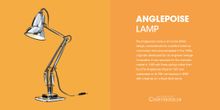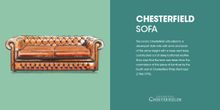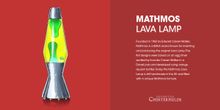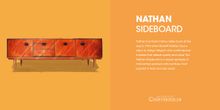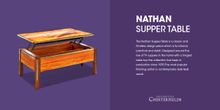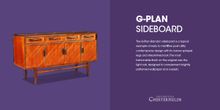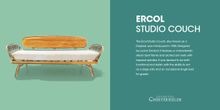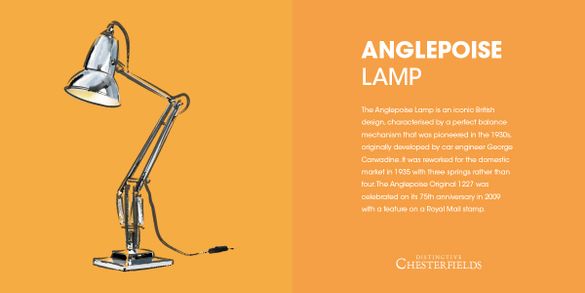 09 Jun 2016
09 Jun 2016
Tags: Furniture, Interiors, Home, House, Design, EU, copyright, Handmade Furniture

It was recently announced that by 28th July 2016, with a six month “amnesty” for retailers until 28th January 2017, creators' copyrights on furniture designs will be extended from 25 years from their death to 70 years in Britain.
This means that under the new legislation, manufacturers selling unlicensed furniture designs in Britain will be at risk of fines of up to £50,000 and jail terms of up to 10 years. Licensors will also likely begin to charge more for reproduction of their work.
Many classic and quintessential British designs which are now able to be purchased as reproduction items at a fraction of the cost of the original will soon become more difficult and more costly to source.
Distinctive Chesterfields have created a series of illustrated images featuring classic British furniture, examples of everything from mid-century contemporary pieces, that may be now be subject to the new copyright legislation, to furniture designs now considered antique that will not be at risk of unauthorised replica fines as the 70 years after the creator's death has passed.
Ercol Pebble Tables
The nest of curved tables often called the “Pebble” nest has become a typical example of a mid-century design classic. Designed by Ercol's founder in 1956, Lucian Ercolani, from whom the brand takes its name, the nest usually comprises of 3 rounded edge tables in decreasing sizes. In recent years they have become available in various wooden and coloured finishes, but the original and most sought after is a blonde wood.
Roberts Portable Radio
Roberts Radio Company was set up by Harry Roberts in partnership with Leslie Bismead in 1932, but it wasn't until 1956 that their infamous 'Revival' R66 design came into being. Inspired by the design of his wife's handbag, this classic British design icon was a breakthrough in style while still retaining good sound quality.
Anglepoise Lamp
The Anglepoise Lamp is an iconic British design, characterised by a perfect balance mechanism that was pioneered in the 1930s, originally developed by car engineer George Carwadine. It was reworked for the domestic market in 1935 with three springs rather than four. The Anglepoise Original 1227 was celebrated on its 75th anniversary in 2009 with a feature on a Royal Mail stamp.
G-Plan Sideboard
The G-Plan Brandon sideboard is a typical example of early to mid-fifties post-utility contemporary design with its narrow splayed legs and streamlined look. The most fashionable finish on the original was the light oak, designed to complement brightly patterned wallpaper and carpets.
Ercol Studio Couch
The Ercol Studio Couch, also known as a Daybed, was introduced in 1956. Designed by Lucian Ercolani, it features a characteristic steam bent frame and arched arm rests with tapered spindles. It was devised to be both functional and stylish, with the ability to act as a large sofa and an occasional single bed for guests.
Mathmos Lava Lamp
Founded in 1963 by Edward Craven Walker, Mathmos is a British brand known for inventing and producing the original Lava Lamp. The first designs were based on an egg timer spotted by founder Craven Walker in a Dorset pub and developed using orange squash bottles. Today the Mathmos Lava Lamp is still handmade in the UK and filled with a unique Mathmost formula.
GPO Rotary Bakelite Telephone
Over time, the style of the General Post Office (GPO) telephone has changed from the old fashioned Candlestick design from the 1920s to the “revolutionary” Bakelite 162 introduced in the 1930s with its pyramid design to the 300 model desk phone that is most widely recognised.
Nathan Supper Table
The Nathan Supper Table is a classic and timeless design piece which is functional, practical and stylish. Designed around the rise of TV suppers in the home with a hinged table top, the collection has been in production since 1970. The most popular finishing option is contemporary style teak wood.
Chesterfield Sofa
The iconic Chesterfield sofa refers to a davenport style sofa with arms and back of the same height with a lower seat base constructed out of deep buttoned leather. Story says that the term was taken from the commission of this piece of furniture by the fourth earl of Chesterfield, Philip Stanhope (1764-1773).
Beswick Flying Ducks
The trio of ceramic flying mallard ducks derive from the home of English pottery, the Beswick Factory in Stoke-on-Trent and date back to 1938. They were part of a larger collection of other flying birds in five sizes including swans, swallows and kingfishers. Being at the affordable end of the spectrum, they became a regular site in mid-century middle class homes.
Nathan Sideboard
Nathan Furniture's history dates back all the way to 1916 when Barnett Nathan had a vision to design elegant and contemporary furniture that offered quality and value. The Nathan Sideboard is a classic example of mid-century post-war retro furniture, most popular in teak and oak wood.
Axminster Carpets
Axminster Carpets came to life in 1755 in its eponymous Devon town. The product was designed and created by Thomas Whitty in a style similar to Turkish rugs. Early versions of the carpet were like pieces of tapestry formed by creating handmade knots in the wool. Today original Axminster carpets can be found at Chatsworth House and Brighton Pavilion, but modern versions are still woven in Devon.
-ENDS-
For more information please contact sian@bronco.co.uk
Notes to Editor:
Distinctive Chesterfields has been trading since 2007 and offers beautiful, handmade chesterfield furniture to its customers.
Making handmade pieces in its West Yorkshire showroom, the company opened a second UK showroom in the London location of Clapham Junction in June 2015, with premises in New York and France launching in 2016.

